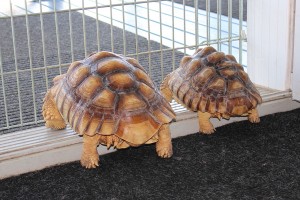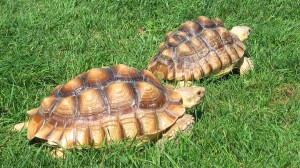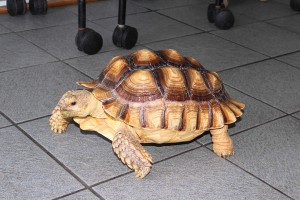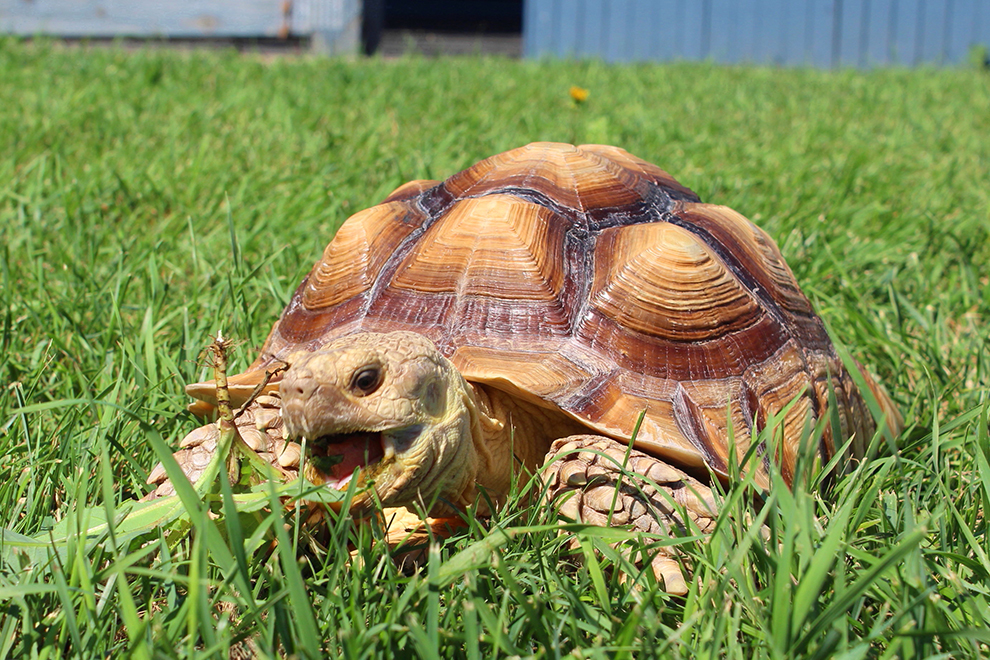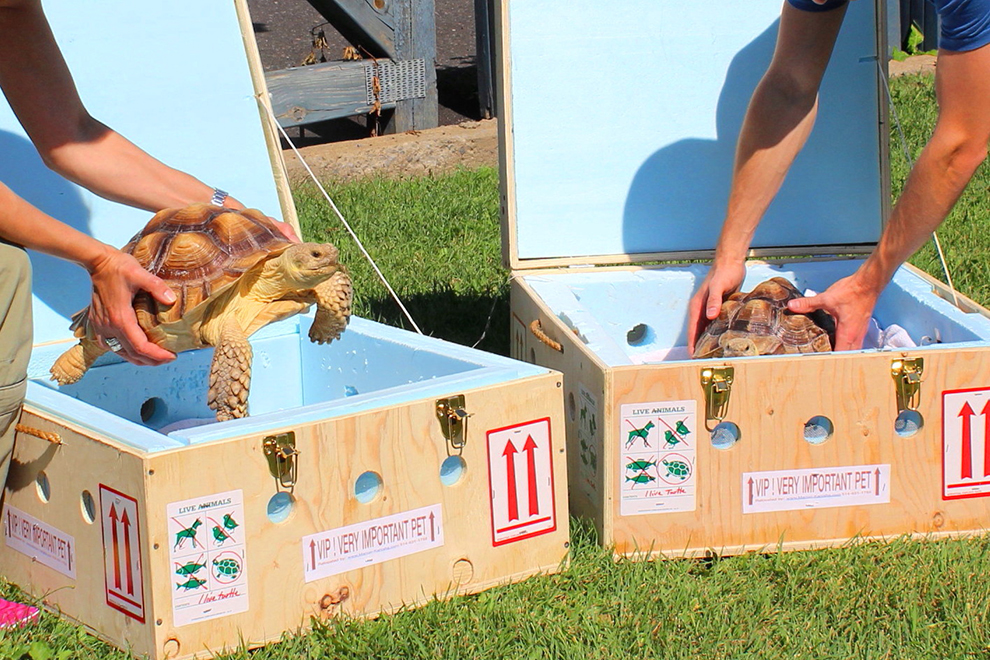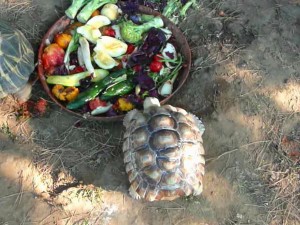Here is the story of two magnificient specimens as told by their owners, 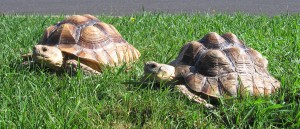
two veterinarians from Montreal, Quebec:
This text was originaly written in French and translated by Tim Harris, Manager of the Manoir Kanisha Int’l Pet Relocation Division.
We adopted ABU and MOMO, two male sulcata tortoises in January 2013. We had the idea of offering them a better life than they had in their small terrarium. In less than 5 months with us each has doubled their weight (adult males can attain 100kgs when fully grown). We had to act fast!
So we found them a tortoise paradise … in the south of France. The owner, Vincent Morcillo, keeps more than 600 tortoises in his incredible garden. The garden is subdivided into different enclosures which perfectly reproduce the biospheres specific to the species (fifteen of them) that he looks after.
After several months of administrative channels to obtain all the documents for the trip, we contacted Manoir Kanisha to assist us in this monumental adventure. They reviewed our file and constructed secure transport containers made to measure in order to guarantee a quiet voyage for our protégés. We were delighted to find them in perfect condition in the cargo section of Nice airport.
After three hours on the road ABU and MOMO eventually arrived at their final destination! It only took them a few minutes to start exploring their new vast and luxurious play space. They met their new neighbours (three other sulcatas and two Star tortoises[i]), they discovered an enormous plate of varied fruit and vegetables, and calmly enjoyed the sunshine. It was painful to leave them although we knew they were in such a paradise.
When we found our two sulcatas, we knew that it would be a real challenge to keep them. These tortoises are frequently sold as juveniles in pet shops and shows. They only weigh a few grammes and are the size of an apple when held in the hand. Unfortunately the internet throws up a mass of people who now wish to dispose of their adult sulcatas. This species has some particular requirements and its size makes its captivity especially challenging particularly in temperate regions.
Like all reptiles, they must be kept at a precise temperature (30oC on average with a maximum of 40oC) and require exposure to a wide spectrum of UV light. They are herbivores and must eat a wide variety of plants, grass and hay, as well as fruit and vegetables. They can eat all day! Our tortoises, at only five years old, can eat three lettuces each per day, with ad lib hay, and still look for more… The cost of feeding, especially in a region where lettuces can cost up to $3 each in winter, rapidly becomes astronomical.
Even more importantly, sulcatas require space, lots of it. These tortoises can exceed 20kg in less than 10 years, and the adult males can achieve 100kgs. It is not sufficient merely to provide a terrarium just large enough to hold them … they can be very active and want to walk about all day.
They have a tendency to dig and try to make underground galleries. In the wild they are capable of making tunnels six feet deep and 15 feet long. This natural behaviour is difficult to control in captivity, particularly if they are kept indoors for eight months of the year (we live in Montreal).
If left free, not only is it difficult to offer them satisfactory temperatures, but their coming and going results in chaotic reorganisation of your home. When they decide they want to go to the other side of a wall, they will push, and keep pushing, sometimes for hours, leaving their owners to repaint and repair, and exasperated by the repetitive noise of the carapace striking the floor.
It gets worse! Sulcatas cannot be properly house trained. At best, we can be trained to their habits, knowing that they generally perform at the same time of day, and that a bath can stimulate defecation. Since we cannot stay and look after them all morning and clean up immediately, we can only live with the mess. Remember that they can constantly move about for several hours, which does not stop them strolling through their own excrement and spreading it all along their travels. The pong is also difficult to dispel.
Finally, you must realise that sulcata tortoises are not really affectionate animals. They can recognise their owner, come to a call, follow you about, but it is usually because they are looking for something in return. Remember, they are really stomachs on legs! Ours will tolerate being stroked, but after only a few seconds they have only one objective to bite our fingers and taste them, even if we don’t have a tit-bit. Thus it can be very difficult and frustrating to provide enough energy and time to provide for their animal needs, whilst they give so little in return.
We acquired them knowing all along the time money and energy we would have to invest in providing them with a better life. And I think we have found it. But we definitely recommend that you do not keep sulcatas in captivity, at least in Quebec! Our two companions have fascinated us with their beauty, and, yes, with their personality, and we are very attached to them. However, we believe that they can best be appreciated in their natural surroundings.
[i] Geochelone elegans is a medium to large size tortoise. The carapace of G. elegans is very convex, with dorsal shields often forming humps; the lateral margins are nearly vertical; the posterior margin is somewhat expanded and strongly serrated. The shields are strongly striated concentrically, giving it its name.
===============================


